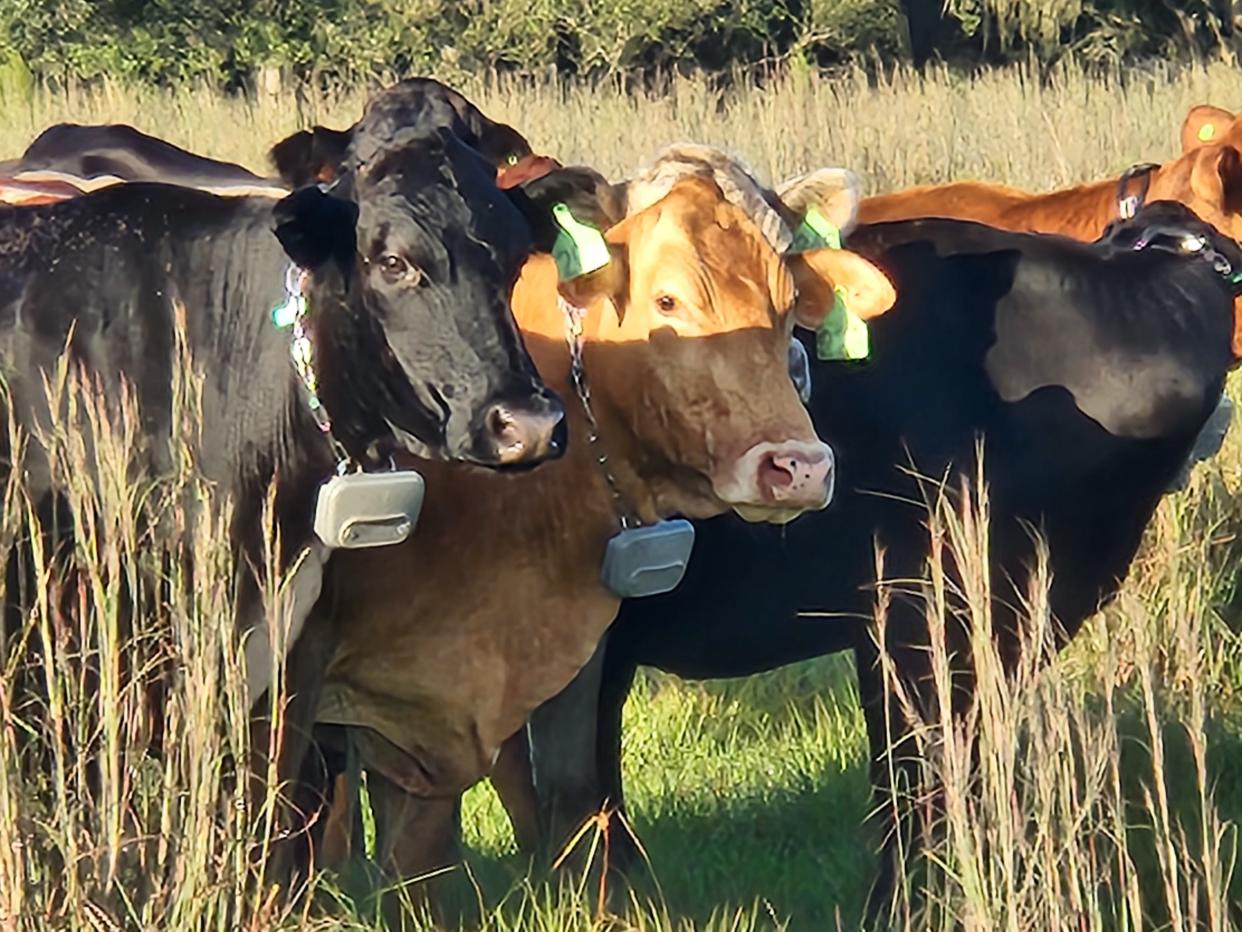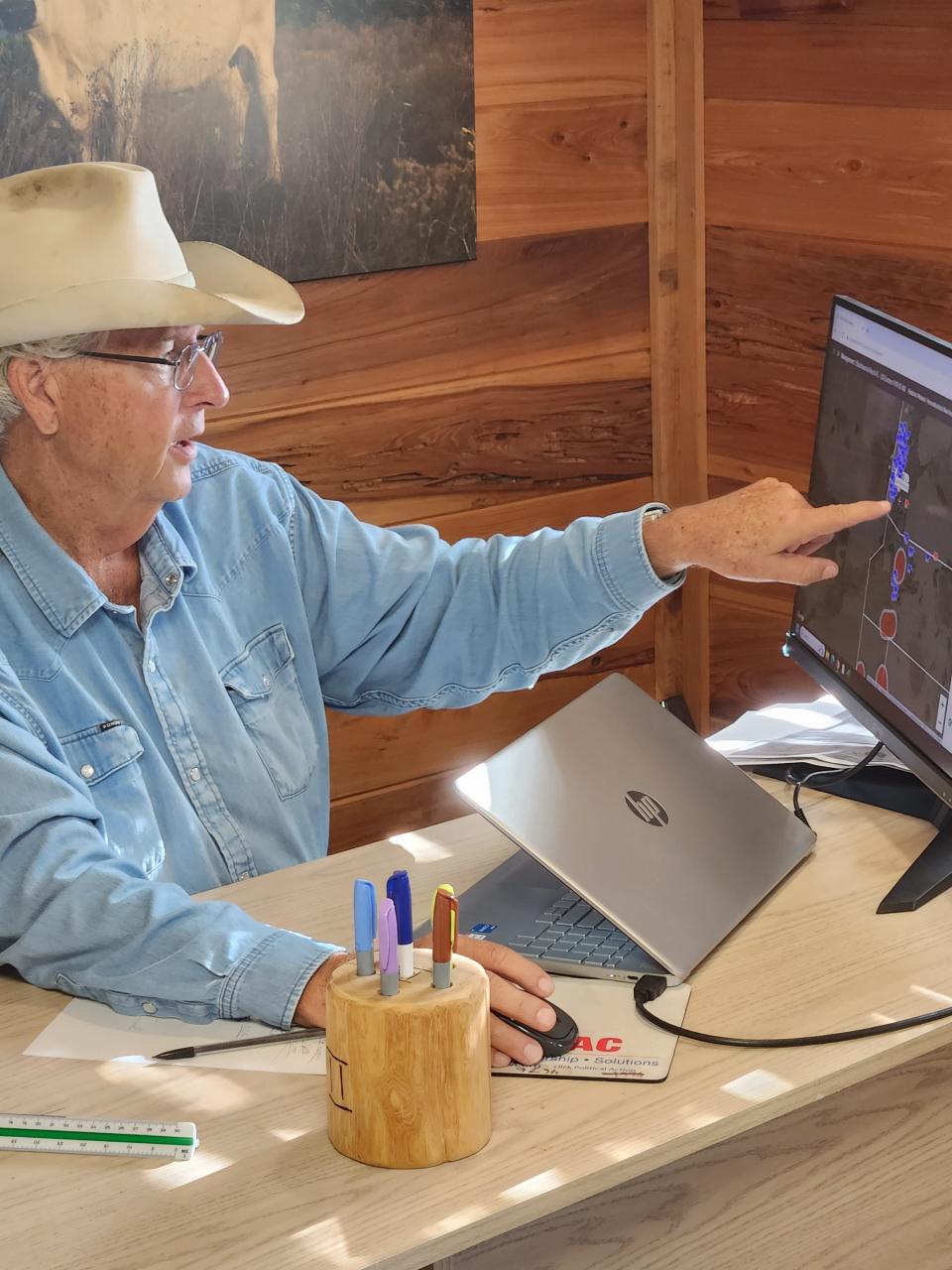No fences? One cattle rancher is testing the use of virtual fencing in Florida

LAKELAND — From his home or wherever he has his laptop computer, Jim Strickland is herding cattle.
Strickland, manager of Blackbeard’s Ranch in Myakka City, is one of the only, if not the only, cattleman in Florida currently using the latest in Global Positioning Satellite technology to manage his herd. In the past, he and other cattlemen would rely on traditional barbed-wire and other types of fencing to keep herds from wandering off, but that fencing could injure cows that got tangled up, impede the flow of wildlife migration and was expensive to install, maintain and replace.
Through what’s being called “virtual fencing,” Strickland is using artificial intelligence to control cattle movement, manage grazing and report on animal health. Strickland’s cattle have been fitted with GPS collars. A A cell tower sends a signal to cattle to keep them within a certain range of generally five to six miles. For cows fitted with collars, if they hit a boundary, they get a slight shock on the top of the neck to back them up. The shock unit has a small solar panel to keep it charged.
From a computer, the cattle can be seen, so the cattle owner knows where their cows are all the time.
In a recent study, 98 of 100 of Strickland’s cattle with GPS collars stayed in their designated areas. Strickland, who says he has a strong sense of environmental stewardship, wants to protect his wetlands, wildlife and the environment, and he can see using the fence to manage land for water preservation, carbon sequestration as well as cattle production.
Currently, on 2,000 acres of Blackbeard’s Ranch in Manatee County, Strickland has 100 of 1,300 cows fitted with GPS tracking collars. In total, Strickland has access to about 15,000 acres in Marion, Desoto, Manatee counties and owns about 200 acres.
The virtual fence technology is manufactured by Vence — a subsidiary of Merck & Co. Inc. in Rahway, New Jersey – and has so far been tested in Oregon, Montana and Idaho, but nowhere in the south or southeastern United States. Strickland said he was anxious to see if that technology would work in Florida.
To pay for his part in the initial virtual fencing project, for 100 head of cows, it cost about $58,000, with funding split between the Natural Resources Conservation Service, a division of the U.S. Department of Agriculture, and some of his own money. Strickland said he manages the environmental data and with Florida's Conservation Group, collaborates where to keep cows.
Each day, Strickland has to change out collars, check cattle, record data and keep research statistics. Every Friday, he meets virtually with Vence representatives in Colorado to get guidance.
“We’re really ramping up the trial and research to get this to where other ranchers will have this. I can literally pull (GPS) up on a computer and see where every cow in that project is. I can see an icon for all those cows on my computer screen,” said Strickland, 68, who has spent his entire life in the cattle industry. “Every 30 minutes, it changes. I can see which way they’re moving, where they are. I can see if two cows were, say, a mile from the rest of them and we can go out to check on them to see if they were bogged in the mud, or having trouble calving, or crippled or something like that. I can see all that from a computer screen.”
To get the virtual fencing trial at the ranch underway, Strickland got Joao Vendramini, a professor at the University of Florida Range Cattle Research and Education Center in Ona, to assist with the first-of-its-kind project in the southeast. Using his own money and funding from the NRCS, he installed cell towers on his property. The NRCS and the Florida Conservation Group are also helping the UF/Institute of Food and Agricultural Sciences (IFAS) with the project, which includes deferred grazing.
Vendramini, who’s been at the research center for 18 years, said virtual fencing technology is only about 3 to 5 years old and his involvement with Strickland’s project has been going on for about six months. He said although Strickland is currently the only cattle producer utilizing GPS fencing to any extent in Florida, he has been getting calls and other inquiries from other ranchers looking to learn more about it.

From June 17 to 24 at the 2023 Florida Cattleman’s Association convention in Marco Island, Vendramini said a GPS cattle tracking session was held and was well-attended. Like Strickland, he said the benefits are the convenience of finding places to graze, which increases conservation practices because it prevents animals from grazing at certain times of the year where they shouldn’t be.
Additionally, Vendramini said the virtual fencing is a good way to track livestock, check health and to see if they’re moving. It’s also good in disaster circumstances, such as hurricanes and wildfires.
“I think this will be another tool that the beef cattle producers will have to manage their herds and their cattle. I’m not sure if it will be widespread, but I think it may be something useful for some specific situations like in rangelands where it’s hard to build fences due to thick vegetation and wetlands,” he said. “I think in those situations it may be quite useful because with this tool, the producers will have a chance to manage.”
It just reopened And now alligator activity is closing a popular trail at Circle B again
No cattle or other livestock has been fitted with GPS collars for virtual fencing yet in Polk County, according to LuJean Waters, president of the Polk County Cattlemen’s Association, cattle veterinarian and eighth-generation Floridian. She said she’s heard discussion from ranchers about using virtual fencing but doesn’t know of any using it in the county at the moment.
“It’s not really feasible as far as the expense versus the reward, so we haven’t had any (ranchers) invest in it at this point,” she said. “Now, it’s tough to say if they ever will with development being so rapid. We’re losing ranches so quickly, (cattle ranching) might not be sustainable in the future.”
Other benefits of the GPS fencing, Strickland said, are when it’s time to move cattle around pastureland and when cows are birthing calves. During calving season, he checks his computer to see if a cow hasn’t moved in a few hours and the cow can be checked on for injuries or sickness. He or someone else can go directly to that one cow to see if she had given birth or why she hadn’t moved in a while.
Strickland said although GPS virtual fencing might not become widespread, it will become more popular.
“I don’t see everybody using it. I can tell you it has exceeded my expectations and the more I learn I see more opportunities for ranchers, opportunities to use this product in the future,” he said. “This helps manage the land for conservation and ecosystems, and we’re managing the land for the cattle. I’m really excited about this.”
This article originally appeared on The Ledger: Virtual fencing for Florida's cattle industry is getting a test

